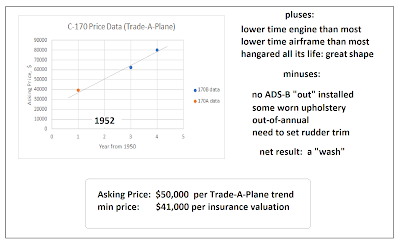----------
In a posting dated 18 January 2014 and titled “Super
Red-Letter Event”, I described
inheriting my Dad’s plane and learning to fly in it. In the last couple of years, I have had some serious health problems that
prevented me flying, culminating in a mild
stroke that has effectively ended my flying.
This aircraft needs to be flown, it will deteriorate if just left in
storage. It really needs an owner who
can take full care of it, which inherently
includes flying it, something I can no
longer do.
This aircraft is truly a vintage craft; I typically referred to myself flying it as
the “antique flying the antique”, but it
is not worn out! It is a
strikingly-classic design, and draws very
positive comments from observers quite often.
That rounded vertical tail is nothing at all like anything you can buy
today. That really attracts
attention, not to mention it being a
tailwheel design.
It is fun to fly, and
easy to fly, although you must be tailwheel-qualified
to fly it (something rare today). Tailwheel
instructors are also now rare, but they
all claim a tailwheel-qualified pilot is actually a better pilot, precisely because he/she must actively “fly”
the plane, even on the ground, from the time the prop starts turning, until it stops turning back at the
hangar. I agree with that opinion. It’s not hard, but it does demand very close attention to
everything, even on the ground. Especially the wind.
This isn’t modern high-speed flying glued to a “glass
cockpit” that does almost everything for you.
It is flying as it was done well over half a century ago: looking out the window and using a real chart
and a VOR to navigate, all the while monitoring
round dial-type gauges on the instrument panel.
It’s not hard, but you need
practice at it, to do it effectively in
the air.
Your piloting skills actually stay sharper if you fly that
way. This is real “stick-and-rudder”
stuff! Yet this particular plane flies
fast enough to be attractive for travel:
it cruises near 110-115 mph. Day
VFR / “stick-and-rudder” is easy in it,
and the most fun of all.
Below is my writeup (complete with a photo) describing this
airplane for prospective buyers. If this
kind of flying appeals to you, and you
might want to buy this plane, do please
contact me. I put the contact data in
the writeup.
GW
----------------------------------
writeup (updated slightly 9-1-19)
----------------------------------
----------------------------------
writeup (updated slightly 9-1-19)
----------------------------------
4-Seat “Old-Time” Cessna for sale. Owner can no longer fly due to health issues.
1952 Cessna 170B, S/N
25336, registered as N2794D, Continental C-145 engine S/N 8188-D-3-2, McCauley 1A170 propeller, S/N 71827.
Original owner’s manual.
Tailwheel aircraft,
requires tailwheel endorsement!
Aircraft has been hangered all its life since being rebuilt from
salvage with a new engine at an estimated 2200 airframe hours, and returned to flight in 1983 (logs date
from then). All metal wing, 3-position flaps, dial-type gages on instrument panel. Cruises at about 115 mph. Easy to fly.
Insured for $41,000 with Avemco (their
professional minimum valuation).
Total time in service 2716.7 hours as of last annual. Engine time in service since last major
overhaul 535.4 hours as of last annual. This
is a relatively low-time airframe, and a
fairly low-time engine! Compliant
with all AD’s as of last annual. Date of
that last annual: January 2016.
Aircraft was flown less than an hour, in a short ferry flight, since that last annual. Stored in T-hangar at McGregor airport ever since, and also hangered ever
since current owner took possession. Was
also always hangered before that, dating
back to its rebuild and return-to-flight.
Rudder trim tab needs adjustment after last repair: replace broken tailwheel leaf spring and repair
associated sheet metal damage to rudder and elevators. This was done during calendar year 2015, preceding that last annual. Ferry flight
revealed a need to add some “R turn” at trim tab on rudder.
Aircraft has proper radio, VOR, and transponder, but lacks ADS-B “out”, which is soon-to-be-required for operation
near towered airports from 2020-onward (there are now less-expensive solutions
for this). Will need a current annual to
return to flight.
Excellent appearance:
paint good. Upholstery good, except pilot and copilot seat covers are
worn, but still very serviceable. Carpet padding and seat foam padding needs replacing.
Contact owner at:
Gary W.
Johnson, PE, PhD
5886 New
Windsor Pkwy
McGregor, TX
76657
254-840-9629
----------------------
end writeup
----------------------
Update 9-1-19:
end writeup
----------------------
Update 9-1-19:
Looking at some recent Trade-A-Plane ads, asking prices depend on the model year. The plot following the photo is that
Trade-A-Plane data. That trend says a
1952 model is worth just about $50,000,
“all else being equal”. The
pluses and minuses are a “wash”, so all
else really is equal, or better. Therefore $50,000 is my asking price. The minimum I would consider is the insurance
evaluation $41,000.



No comments:
Post a Comment